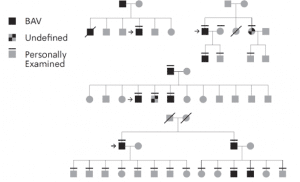Bicuspid Aortic Valve: Identification of a New Genetic Pathway

Bicuspid aortic valve is the most common congenital heart malformation, with an incidence in the population of 1%. It is associated with significant cardiac complications that often necessitate surgical repair.
Researchers from the Cardiology Division recently identified a cohort of 28 families (70 affected individuals) with this abnormality, and used their genetic information to identify a new genetic pathway that leads to developmental abnormalities of the heart.
Dr. Idit Gabai worked on this project as for her senior medical thesis, with Dr. Ronen Durst and Professor Dan Gilon. This was a multi-step complex genetic study using tools from familial genetics and pioneering new approaches in genetic data analysis.
The first step was exome sequencing of 28 family pedigrees, including 70 individuals from Israel and France. This type of sequencing isolates the active portions of the DNA and sequences them, making the process more efficient and more economical. They then isolated the mutations that were consistent in all the families. The team then made sure that none of the mutations that they identified had already been reported as disease-causing mutations.
They then used a unique strategy for genetic analysis, using available genetic “big data” to identify potential disease-causing mutations, using 2 key steps:
First, they excluded all the mutations that are common in the population– keeping only rare variants with frequency of less than 1 in 1000 in the general population. They then analyzed each of the remaining mutations to identify those variants that are predicted to adversely affect the function of the protein generated by the gene.
In the second step, they cross-referenced the resultant genes with genes that are known to be involved in cardiac development in humans and/or mice.
The analysis process yielded 7 final candidate genes, and of these genes, the most promising candidate was MINDBOMB1 (MIB1.) This gene is involved in a pathway that is highly active during cardiovascular development, and it is involved in nuclear signaling and gene transcription.
In the cohort, they found 6 different variants in the MIB1 gene, three nonsense and three missense mutations
The team then evaluated the pathogenicity of these mutations using several methods:
- Modeling of the protein structure of the protein found that these mutations affect the active parts of the protein.
- Together with our colleagues in Spain, they assessed models of this mutation in zebra fish. Injection of mutant mRNA based on this mutation into zebrafish embryos led to maldevelopment of the heart.
- In mice, they assessed the impact of this mutation in mice who already had some loss of function in the cardiac developmental pathway. These mice developed bicuspid aortic valves, as well as other cardiac abnormalities.
- They also created a MIB1 knockout mouse. All of these mice developed developmental cardiac mutations, including bicuspid aortic valve, quadracuspid aortic valve, and ventricular septal defects.
This exciting work identified MIB1 as a novel gene for the development of bicuspid aortic valve. Next steps are more studies of this genetic pathway, and the team plans to look at the other 6 candidate genes that they identified. These findings may ultimately lead to gene therapies that mitigate the progression of disease. Stay tuned!
Search
Recent Posts
Abuse and Heart Disease
Abuse and Heart Disease: Exposure to trauma and...The Fake News Fiasco
We are exposed to a tremendous amount of inform...Coaching For Change
The Pollin Center’s health coaching group is an...When on-line is off limits: Innovative Corona-tailored health promotion program for Ultra-orthodox women – Chevruta L’Chaim
Ultra-Orthodox (Haredi) women have worse health...21444
The stress, apprehension and the fears coupled ...

